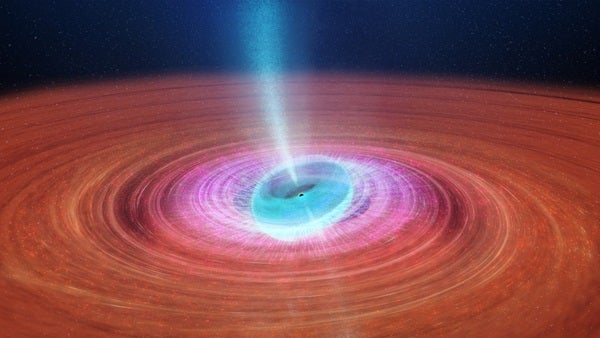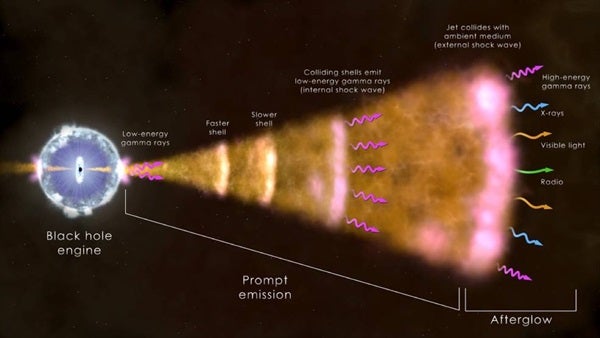
On Oct. 9, 2022, the orbiting Swift and Fermi gamma-ray detectors observed the brightest gamma-ray burst (GRB) ever seen: GRB 221009A. Astronomers around the world quickly responded by turning as many telescopes as possible to the location of the GRB, ultimately spending more than two months collecting follow-up observations.
Now, some astronomers who have been poring over the follow-up data have concluded that evidence of a supernova could indeed be buried in the glow of the GRB’s aftermath. If confirmed, the find would support the prevailing view that GRB really are part of the explosive process that sees massive stars collapse into black holes.
A paper detailing the discovery of GRB 221009A was published March 28 in The Astrophysical Journal Letters. Another study analyzing the GRB’s light curve and possible supernova signature was also published in the journal the same day.
What causes a gamma-ray burst (GRB)?
Gamma-ray bursts are the most intense outpourings of energy known in the universe. But their exact nature is still a matter of debate and ongoing research. Astronomers currently think that GRBs are sometimes caused by the collapse of particularly massive stars. But other GRBs are thought to be the result of two colliding neutron stars — or perhaps different processes altogether.
Robert Kirshner, director of the Thirty Meter Telescope International Observatory project and a longtime expert on supernovae who was not involved in either study, tells Astronomy that when GRBs were first found in the 1980s, “there were as many theories for what these might be as there were actual events.”
But now, he says, “the prevailing view is [that GRBs] are related to supernovas. They’re found when massive stars are gone and their core collapses probably to a black hole rather than a neutron star.”
Understanding the brightest GRB yet
GRB 221009A was not the most powerful gamma-ray burst ever detected in absolute terms. But its combination of intrinsic brightness and its relative proximity to Earth made it by far the brightest ever observed.
In fact, “GRB 221009A was likely the brightest burst at X-ray and gamma-ray energies to occur since human civilization began,” Eric Burns, an astronomer at Louisiana State University, said in a NASA release.
But because GRB 221009A’s initial radiation outburst was so strong, detecting a supernova signature buried within it is an extremely difficult task. That’s why a team of astronomers led by University of Cardiff professor Stephen Smartt and doctoral student Michael Fulton used the PanSTARRS telescope in Hawaii, as well as data from several other telescopes around the world, to monitor the light from the dimming object until it passed out of sight behind the Sun in December. The team says that although the signal is weak, they do see evidence that the GRB’s dimming light includes the telltale brightening signature of a supernova.
GRB 221009A falls into the category of “long” gamma-ray bursts, which means anything that lasts longer than a few seconds. “Most, but not all, of these long GRBs have been associated with a supernova which has emerged 10 or 20 days later,” Smartt tells Astronomy. “So, the idea is that that gives the signature of the immediate death of a massive star and probably the formation of a black hole.”
When an accretion disk forms around a black hole, it can lead to the ejection of a concentrated jet of energy. And when that jet sweeps across Earth, we see it as a long GRB.
“But there’s also material that’s ejected at supernova speed, a few tens of thousands of kilometers per second, not the speed of light as in the jet,” says Smartt. When that material slams into gas in the surrounding interstellar medium, it heats it up to produce the bright flash seen as a supernova. And that flash arrives just as the brightness of the black hole’s initial jet is dying down.

There have been a few exceptions, Smartt says, where no supernova was seen after a long GRB, but those were peculiar cases. So, he says, it’s of great interest to see whether this brightest GRB of all fits the expectation or turns out to be an exception.
To find out, Smartt and his team carried out the longest and most extensive of the many sets of observations carried out on GRB 221009A’s declining brightness. After months of careful analysis, he and his large international team of collaborators say they see evidence for the expected slight bump of a supernova in the GRB’s declining light curve. This bump, they say, matches well with predictions for the expected supernova signature.
One other team has also reported detecting signs of the buried supernova. But some other teams have reported negative results. So, for now, the question remains unsettled.
More to learn about GRB 221009A
Further follow-up work is required to resolve the question of what really caused GRB 221009A, Smartt says. And that work can take at least two forms.
The first approach is continuing to analyze the existing data. And one planned project aims to combine all the data collected by the different observing teams to provide a richer, deeper set of measurements for GRB 221009A’s light curve.
Second, once GRB 221009A’s part of the sky reemerges from behind the Sun, researchers can capture much longer and deeper images of the region where the blast occurred. This, Smartt says, will provide the highly detailed background data needed to subtract it from the GRB’s light curve. That will provide a much more reliable picture of GRB 221009 A’s evolution, helping reveal whether the claimed supernova brightening was indeed real, or just a spurious artifact.
Kirshner says that “the radio emission should be detectable for years, so as you gather more information and you see how it evolves, you have more of a grip on what the physical phenomenon is, and you can kind of puzzle it out better.”
He also says some researchers now think the supernova signal is indeed buried in the GRB data. But he adds that others have looked at data, including that from the James Webb Space Telescope, and don’t see any signs of a supernova. “I would say it’s unclear,” he adds.
”That might be the most interesting thing: the ambiguity,” says Kirshner. We’ve only seen relatively few of these GRB-supernova associations, he says. “Who knows if we’ve seen all the different types?”
Either way, pinning down exactly what happened with GRB 221009 will be a valuable addition to our understanding of these mysterious, powerful events. And confirming the observation would help to establish that we do indeed have a pretty good understanding of GRBs.
On the other hand, Smartt says, “If we don’t find a supernova, that’s potentially more exciting” than the actual detection, since that would require a whole rethinking of the models.









